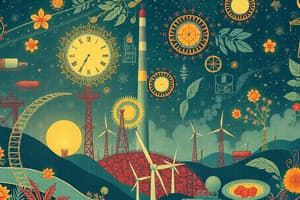Podcast
Questions and Answers
Which of the following energy sources is considered renewable?
Which of the following energy sources is considered renewable?
- Biomass energy (correct)
- Geothermal energy (correct)
- Nuclear energy
- Fossil fuels
What process transforms biomass from photosynthetic organisms into fossil fuels?
What process transforms biomass from photosynthetic organisms into fossil fuels?
- Geologic burial and transformation (correct)
- Photosynthesis
- Nuclear fission
- Combustion
Which source of energy is classified as non-renewable?
Which source of energy is classified as non-renewable?
- Biodiesel
- Fossil fuels (correct)
- Wind energy
- Solar energy
Which statement about renewable energy sources is true?
Which statement about renewable energy sources is true?
Which of the following is NOT a consequence of energy distribution?
Which of the following is NOT a consequence of energy distribution?
What primarily drives the creation of wind energy?
What primarily drives the creation of wind energy?
Which country generates over 99% of its electricity from renewable sources?
Which country generates over 99% of its electricity from renewable sources?
Which of the following sources is derived from the gravitational pull of celestial bodies?
Which of the following sources is derived from the gravitational pull of celestial bodies?
What type of energy can be defined as finite and not replenishable within a human timescale?
What type of energy can be defined as finite and not replenishable within a human timescale?
Flashcards are hidden until you start studying
Study Notes
Energy Sources
- Energy sources for our daily activities come from various natural sources like the earth's core, the sun, and moon's gravitational pull.
- Geothermal energy is generated from Earth's core.
- The gravitational pull of the moon and sun create tides.
- The sun's light energy powers the water cycle, creates wind, and enables photosynthesis.
- Through photosynthesis, plants, algae, and cyanobacteria create biomass that can be used for biofuels.
- Over millions of years, biomass transforms into fossil fuels through heat and pressure.
- Energy sources are classified as renewable or non-renewable based on their replenishment rate.
- Renewable energy sources, like solar, wind, and biomass, can be replenished within a human lifespan.
- Non-renewable energy sources, like nuclear energy and fossil fuels, take millions of years to form.
- All energy sources have environmental and health costs, and energy distribution varies globally.
- The US generates less than 10% of its energy from renewable sources, while Costa Rica generates over 99% of its electricity from renewables.
Studying That Suits You
Use AI to generate personalized quizzes and flashcards to suit your learning preferences.




